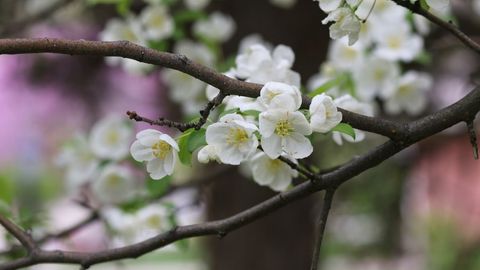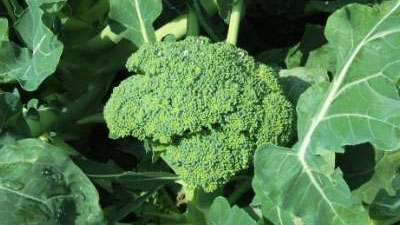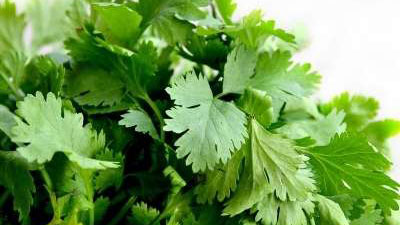Apple Production and Variety Recommendations for the Utah Home Garden
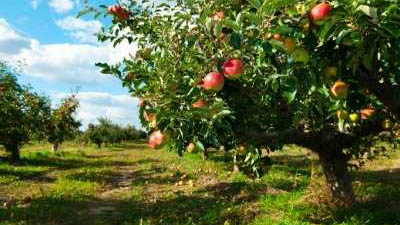
Summary
This bulletin presents appropriate information pertaining to growing apple trees in the home orchard. Success depends on several key factors. These include:
- Ensuring soil is amenable to apple production and selecting an appropriate site
- Choosing appropriate varieties for the local climate that are additionally compatible for cross pollination
- Selecting healthy trees • Fruit thinning and harvesting techniques
- Common pest and diseases
Introduction
Over 2,500 varieties of apples are grown in the United States alone and over 7,500 worldwide. Those recommended in this publication were selected for overall popularity, ability to grow in Utah, and general availability. Some listed varieties are less common and may need to be purchased via mail-order or from online retailers.
As with most things, proper planning helps ensure success. This principle applies to successfully growing apples in the home orchard. Aspects to consider before purchasing include soil testing, appropriate site selection and choosing suitable varieties. Once planted, it is necessary to be familiar with how to care for trees. Principles of care include pruning; thinning and harvesting techniques; and pest and disease management.
Planning and Preparation
Site and Soil Requirements
Sunlight is one of the keys to maximizing fruit production. If possible, choose an area with full sunlight most or all of the day. Early morning sun is particularly important to dry moisture from rain, irrigation sprinklers or dew from the trees and fruit, thereby reducing the incidence of diseases. Ideally, do not plant trees in the lawn to avoid mechanical damage from mowers and trimmers; competition for nutrients between turf and trees; improper irrigation; and disease problems associated with excessive moisture landing on leaves from sprinkler irrigation.
Apple trees are adapted to many soil types but prefer well drained soil and should not be planted where water stands for more than 24 hours unless soil drainage can be improved. In poorly drained areas, roots do not receive enough oxygen due to excessive water in the soil, resulting in stunted growth and possible eventual death. Before purchasing, homeowners should perform the following:
- An inexpensive soil analysis of the potential planting area. Testing reveals soil type and other important characteristics and can be performed by the Utah State University Analytical Laboratory. Specific instructions on soil testing can be obtained from “Soil Testing Guide for 2 Home Gardeners” accessible at http://extension.usu.edu/files/publications/factsh eet/HG_H_05.pdf.
- Amend soil according to the test (if needed). If you have questions about interpreting your results, contact your local USU Extension horticulture or agriculture agent.
Climate and Microclimates
Most apples are relatively cold-hardy. However, a more important factor to consider is when fruit ripens. In areas with shorter growing seasons, apples that require long growing seasons to ripen are not appropriate. In areas with the shortest season, summer ripening apples may be the only option. Table 1is organized in order of approximate fruit ripening dates. Refer to it to find appropriate apples for your area. Additionally, Table 2 lists frost information for many areas of Utah. It includes average length of frost free days as well as average first and last frosts. Apples tolerate some frost. Some believe that light frost additionally improves flavor. Keep in mind that apples should ripen at the same approximate time or before the average last frost in your area.
Overall cold hardiness is additionally important. It is determined by the minimum temperature that a plant can tolerate. The United States Department of Agriculture has developed a uniform system that gives information on average minimum temperatures in a defined area. These areas are designated as zones using a number system. Much of Utah’s Wasatch Front is currently included in zones 5 or 6. Zone 5 minimum average winter temperatures are between -10 and -20 F°. Zone 6 is between 0 and -10 F°. Utah’s colder mountain valleys are generally included in zone 4, having average minimum winter temperatures between -20 and -30 F°. Cold hardiness is listed by zone in Table 1 for specific varieties. For more specific climate information for your location, visit the Utah Climate Center http://climate.usurf.usu.edu/
A microclimate is a defined small area with a slightly different climate than surrounding zones. Microclimates may be warmer or colder can and impact plant survival and performance. For example, trees planted near the south and west sides of structures may bloom earlier due to increased reflected heat exposure from afternoon sun. In certain situations, earlier blooming makes trees more susceptible to frost damage. However, increased heat realized from this sort of exposure may be more amenable to growing varieties that may not otherwise ripen fruit due to the lack of an appropriate frost free season. Conversely, trees planted in the shade of north and east sides of structures may have slightly delayed blooming and ripening due to decreased heat exposure from the sun.
Another situation to watch for is zones at slightly lower elevation where cold air may be trapped. These spots may experience earlier frost and be colder than other areas. This is not the place to grow a variety that is marginally hardy or that may not regularly ripen due to the shortness of the growing season.
Bloom Time and Pollination
Consider the following:
- Almost all apple varieties require cross pollination, meaning that two separate varieties are needed to produce fruit.
- Two trees of the same variety will not cross pollinate each other.
- Successful cross pollination is largely a function of bloom time. Apple bloom time can be divided into early, mid-season and late. Early blooming types will not adequately pollinate those that are late flowering. However, mid season bloomers usually pollinate both. Table 1 gives information pertaining to bloom time.
- Many crabapples also serve as excellent cross pollinator trees. Note that Springsnow crabapple, an extremely common landscape tree, will not cross-pollinate other apple varieties.
- If you live in a neighborhood where multiple homes have different varieties of apples or crabapples, you may be able to plant one tree instead of multiple trees.
- A few apples varieties are not suitable for pollinating any others. These include ‘Crispin (‘Mutsu’)’, ‘Jonagold’, ‘Snapp Stayman’ and ‘Winesap’. Other pollination incompatibility will be listed with specific varieties in Table 1.
Strain Selection
Some varieties of apples such as ‘Red Delicious’, ‘Golden Delicious’, ‘Gala’, and ‘Fuji’ are available in multiple strains. A strain is a mutation of a variety that has been selected and propagated for an “improved” characteristic such as darker red fruit color, earlier ripening, larger fruit size, or growth habit. More than 250 different strains of ‘Red Delicious’ apples have been described and cultivated. Strains may be spur-type (small short twigs that bear apples) or non-spur-type. Spur-type strains are ideally suited for home gardeners with space limitations because fruit spurs and leaf buds are more closely spaced and this reduces overall tree size). Varieties with spur-type strains are listed in Table 1.
Standard, Semi-Dwarf and Dwarf Trees
Factors that influence tree size include the root-stock level of care, variety, soil type, earliness of fruiting, time of pruning and severity of pruning. Of these, the particular rootstock a tree is budded or grafted onto is of 3 particular importance. Apple tree sizes are classified into three categories: standard, semi dwarf and dwarf. These sizes are determined by rootstock. Standard trees grow 40 feet tall. Semi dwarf trees are propagated on one of a number of vegetatively propagated rootstocks that produce trees 50 to 80% the size of standard trees. Dwarf trees mature between 10 and 25% the size of a standard tree.
Table 3 lists a number of common rootstocks. Many vendors also list the rootstock used on the information tag at the point of purchase. The M.9 rootstock is the most widely used commercially. Trees grafted onto it are extremely precocious (trees bear earlier than they normally would) but have a relatively weak graft union. Unless you can espalier—train trees or shrubs onto a trellis on which they are trained to grow flat—or provide another type of support, M.9 is not recommended for the home garden.
Semi-dwarf trees on M.7 rootstock (a common rootstock for trees destined for home gardeners) can be grown free standing and are more suitable for most home garden situations. Dwarf trees often require support from a trellis or post and require different and often more maintenance than semi-dwarf and standard trees. Those planting dwarf trees should become familiar with how to properly maintain them. Dwarf trees produce normal sized apples, just fewer of them, compared to a normal sized tree.
Purchasing Trees
After researching what varieties are suitable for local conditions and conducive to your intended use, you are ready to purchase. Retail informational tags attached to trees are helpful and offer basic information. Keep in mind these tags are generally printed for a national audience and may not completely pertain to local growing conditions.
Carefully inspect for diseases, mechanical damage and spiraling roots. Scrutinize for broken branches and trunk damage. Minor damage is common due to how the plants are harvested and shipped and will not affect the overall health of the tree. The roots of bare-root trees should be inspected for damage and moistness. These roots should be kept damp otherwise damage or death could occur. Remember that a small tree with a good root system is more desirable than a large tree with a poor root system.
Once purchased, roots of bare-root plants and leaves of containerized trees should be protected while transporting. Ensure roots are moistened and surrounded in a wind resistant wrap. Lay down containerized trees with the container towards the front of the vehicle. In warm weather, cover trees with a tarp to protect from wind scorch.
How to Grow and Care for Apple Trees
Preparation and Planting
Dig the planting hole two to three times wider than the root system of the tree and deep enough to just meet the root collar. If needed, compost may be mixed into the back-fill soil at a ratio of 1 part compost to 3 parts soil. For more information about planting, access the following webpage: http://extension.usu.edu/files/publications/publication/N R-460.pdf.

When planting, it is imperative that the root-collar beat ground level

When trees are planted in turf situations,
remove turf 18 inches in a circular pattern
in all directionsfrom the trunk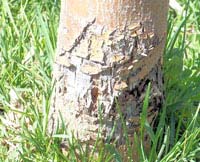
When turf is not removed, damage occurs
from string trimmers and mowers that stress
and cause trees to be excessively prone to
pests and diseases.
Training and Pruning
Begin pruning and training trees in the first late winter or early spring following initial planting. Neglect will result in poor growth and delayed fruiting. Pruning a young tree controls its shape by developing a strong, wellbalanced framework of scaffold branches. Unwanted branches should be removed or cut back early to avoid the necessity of large cuts in later years. The preferred method of pruning and training apple trees in the home orchard is the Central Leader System. More information on fruit tree pruning can be found in the following publication entitled “Pruning the Orchard”: http://extension.usu.edu/files/publications/publication/H G_363.pdf.
Mention of an environmental disease called Southwest winter injury that is prevalent in Utah should be made. It occurs when bark on the south and west sides of a tree is exposed to the sun during winter months. This causes sap flow during the day. At night, this sap in the conductive tissue of the bark freezes and eventually causes cells to burst. To prevent this, tree trunks and lower limbs should be wrapped with fabric tree tape, available at local garden centers and farm stores, in late fall and removed the next spring. Another option is to paint sun exposed portions of the trunk with water based latex paint diluted 50% with water in late fall.
Fertilization
Once trees are planted consider the following:
- Trees that have been in the ground for 1 to 3 years should be fertilized annually in late winter or early spring with approximately ½ cup of ammonium sulfate (20-0-0). This is equal to approximately 1 oz of actual nitrogen. Trees that have been in the ground for 4 years or more, should only be fertilized if needed. This can be determined by overall tree health, amount of fruit produced and annual new growth. If these are all satisfactory, do not fertilize. Younger trees should grow between 12 to 15 inches annually. Older trees growth (planted longer than seven years) should be between 8 to 12 inches annually. In dwarf trees, as little as 4 to 6 inches of growth per year is acceptable.
- If trees are not growing satisfactorily, a noticeable reduction in fruit production has occurred, or is otherwise unhealthy; obtaining further soil and tissue analyses may be useful. For information pertaining how to collect tissue samples access the following fact sheet entitled “Soil, Water and Plant Tissue Testing in Utah Orchards” located at http://extension.usu.edu/files/publications/public ation/AG-FG-02.pdf. Additionally, as trees mature, do not exceed 5 cups of ammonium sulfate (approximately 12 oz of actual nitrogen) per year per tree.
- Heavily pruned trees are more vigorous and require less nitrogen. Some varieties of apple trees are also naturally faster growing and may require no fertilizer to maintain acceptable growth and fruit production. • Over fertilization actually reduces fruit production and makes trees more susceptible to pest and diseases.
- Retest soil every 3-4 years to determine what nutrients (if any) need to be applied to the soil.
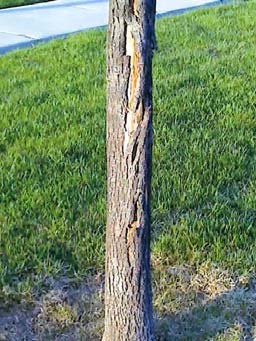
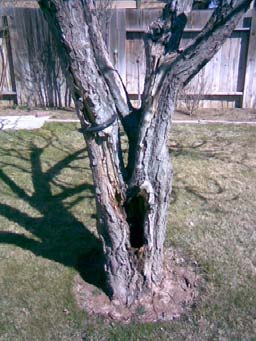
Examples of southwest winter injury. (Images courtesy of Taun Beddes).
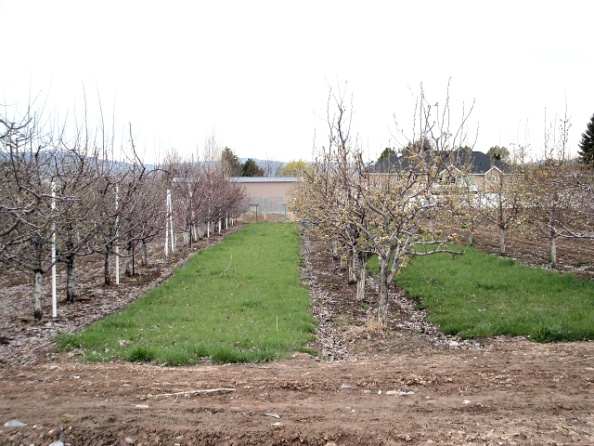
An apple orchard with drought resistant turf used between rows. This can make working in the
orchard easier in wetweather and eases possible soil compaction problems. Notice weeds are
controlled between rows and no turf is planted near the root zones of the trees.
Irrigation
In almost all areas of Utah, supplemental water is required for healthy tree growth. Young trees should be watered every 4 to 10 days based on the soil type and temperatures. If trees are planted in well drained soil, irrigating more frequent is usually needed more than in heavier soils where deep soaking every 7 to 10 days is often adequate. Mature trees need deep watering about every 2 weeks during the growing season so that moisture reaches a depth of 2 to 3 feet. This deep irrigation encourages a well establish deep rooted tree. Do not irrigate too early in the spring. This can cause root rot diseases and nutrient deficiencies. If you have lawn around your trees (this is not recommended), slightly increase nitrogen fertilization and maintain adequate soil moisture at the deeper level for the tree. For more information on orchard irrigation, see http://extension.usu.edu/files/publications/publication/H orticulture_Fruit_2008-01pr.pdf.
Weed Control
Eliminating weed competition in an area 3 feet in circumference around the trunk is critical for tree health and rapid growth, to free soil nutrients and moisture. Frequent hand pulling and shallow cultivation, no deeper than an inch, controls weeds and minimally disturbs roots. Deeper cultivation disrupts shallow roots and is not recommended for young, establishing trees.
Around established trees, slightly deeper cultivation is more acceptable. Additionally, mulches are excellent for weed control. Apply them 2-3 inches deep around the root-zone of the tree, while keeping away from the trunk itself. If mulch comes into contact with the trunk, it can encourage rodents feeding on vascular tissues in the trunk and damage or kill the tree.
Additionally, herbicides are available that effectively control weeds, but are hazardous if used carelessly, especially glyphosate products and common broadleaf weed killers. These should not come into contact with the trunk, young roots or any root-suckers. Do not apply lawn weed killers (Weed-B-Gone type products) in the root-zone of trees. Active ingredients in these can stay active in the soil for weeks to months and be absorbed by trees. Chemical weed control should not be attempted unless the user is experienced and all aspects of safety, sprayer calibration, and understands the product label.
Fruit Thinning
Apples often set more fruit than they are capable of properly maturing. Thinning improves fruit quality by encouraging satisfactory color development and improved shape and size of remaining apples. It also maintains the health of trees and influences the next year’s apple crop. Thin apples before flower buds for next year are produced, between 4-6 weeks after full bloom. When thinning occurs before this period, a tree is more apt to produce sufficient flower buds for the next year. Failure to thin by early summer decreases flower bud formation for the next year’s crop and causes trees to alternate between heavy and light fruit crops or no crops at all.
For homeowners, thinning should be performed by hand. Leave only the largest apple in a cluster, and space apples about every 6-8 inches along the branch. To remove fruit without damaging the spur or other apples on the spur, hold the stem between the thumb and forefinger and push the fruit from the stem with the other fingers.
The insecticide carbaryl (Sevin) is commonly available for insect control in apples, but excessive thinning may be a by-product of its use if applied shortly after petal fall. Consider using another product early in the season. Insecticides should never be applied when trees are in bloom.
Harvesting
Ripening occurs anywhere from late July to mid November depending on the variety and local climate. Trees that ripen earliest, usually in July and August, are referred to as summer apples. These are suitable for many purposes but must be used quickly, as they do not store well. Later ripening apples can usually be stored for a number of weeks to months and are useful for many purposes. The latest ripening apples are not suitable for most areas of Utah and their quality is strongly influenced by early frosts. Fruit picked early 6 and unripe does not store well and does not develop full flavor. Approximate ripening dates, timed for the Wasatch Front, can be found in Table 1.
Determining when apples are ripe can be challenging. One of the best methods is simply by taste. If the apple tastes like it is supposed to, it is most likely ripe. Other indicators of ripeness include:
- Color change of skin from green to yellow or green to red. This color change from green is additionally a good indicator in determining ripeness in apples with yellow as a background color and red as a primary color.
- Healthy apples dropping from the tree around the time that they should ripen.
- Flesh between the skin and core of many red types changing from a greenish color to white.
- When apples can be easily removed from the tree without damaging the spur.
- When seeds in the core turn dark brown.
Remove apples from the spur by pulling upward and outward while rotating the fruit slightly. On some of the thin, long-stemmed varieties such as ‘Golden Delicious’, it is sometimes necessary to firmly place the index finger at the point of attachment of the stem and spur to prevent the spur from breaking. Research has shown that apples picked with their stem attached to the fruit will keep longer than ones with the stem removed.
Disease and Insect Control
View more detailed information on apple insects and diseases from Utah Pests.
Producing the best fruit requires control of diseases and insects. Diseases and pests common to Utah include fire blight and powdery mildew, spider mites, scale, aphids and codling moth. Guideline to home orchard fruit spraying is available from your local USU Extension Agent, and you can sign up for weekly fruit tree pest advisories. More information about apple tree insects and cover sprays can be found in “Utah Home Orchard Pest Management Guide,” http://extension.usu.edu/files/publications/factsheet/hom e-orchard-guide.pdf and at the USU IPM Web site, http://utahpests.usu.edu/insects/htm/factsheets/by=categ ory/category=34. You can additionally register to receive the weekly pest updates at: http://utahpests.usu.edu/ipm/htm/subscriptions
Fire blight is especially damaging at times due to the rapid nature in which many trees decline and its prevalence in most areas of Utah, especially during wet, warm springs during flowering. Apple varieties such as Jonathon, Jonagold and Gala are extremely susceptible. Root-stock additionally influences susceptibility, where some are more resistant than others. Unfortunately, the consumer has little control over which rootstock a particular variety is grafted onto, especially when purchasing from local vendors and box stores. Some mail order catalogs list what rootstock the tree has been grafted onto or may even list more than one rootstock choice that may be ordered. With some research, this information can be useful for choosing rootstocks with desired characteristics. For further information concerning fire blight, access the following factsheet: http://extension.usu.edu/files/publications/factsheet/fireblight-08.pdf. Information concerning varietal fire blight resistance can be found by variety in Table 1. Rootstocks with Geneva (or an abbreviation of the letter G) in the name are additionally resistant, but availability is limited. For more rootstock information see Table 3.
Codling moth is the most common damaging insect of apple fruit. To be controlled successfully, several applications of an insecticide are usually needed throughout the growing season. Further specific information about this insect can be found at http://extension.usu.edu/files/publications/factsheet/codli ng-moths06.pdf
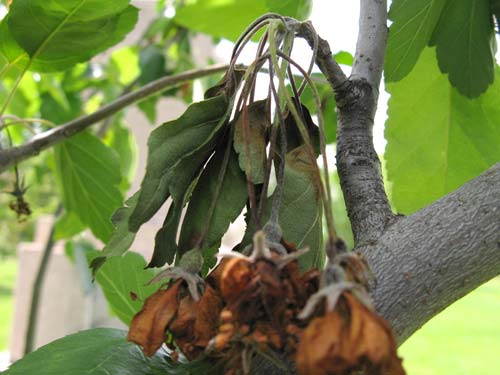
A newly infected branch with fire blight (Photo courtesy of the USU Pest Lab).
Table 1. Approximate Apple Ripening Dates Along the Wasatch Front and Descriptions.
| Variety | Hardiness Zone | Bloom Season | Time of Ripening | Fire Blight Resistance | Comments and Description |
|---|---|---|---|---|---|
| Yellow Transparent | 3-8 | Early | Late July to Early August | Susceptible | Popular, relatively disease resistant, summer apple, a sweet flavor. Useful in colder areas of Utah. Does not store well. It also can be used for sauce. |
| Lodi* | (3)4-7 | Early | August to Early September | Very Susceptible | Popular summer apple. Useful fresh or in pies, sauces and cider. It does not store well. |
| Zestar™ | 3-6 | Mid | Mid to Late August | Very Resistant | Ripens early and is crisper than other summer apples. It can be eaten fresh or used for cooking. Can be stored for up to 2 months. Better suited to colder climates. |
| Sansa | 5-7 | Mid | Mid to Late August | Susceptible | Well balanced flavor with hints of both sweet and tart. Disease resistant. Store for 6 to 8 weeks. |
| Ginger Gold | 4-8 | Mid | Late August to September | Very Susceptible | A newer variety similar to Golden Delicious. Popular for eating or salads due to its sweet flavor with tart undertones. Resistant to browning but does not store well. Susceptible to fire blight. Those growing the apple should adopt management strategies to suppress infection. |
| Earligold | 4-7 | Mid | Late August to Early September | Very Susceptible | A summer variety with improved flavor over older summer apples that stores longer. It may require multiple pickings but can be used fresh, for cooking and processing. |
| Akane (Tokyo Rose) | 4-8 | Early to mid | September | Moderately Resistant | Its taste is similar to Jonathon and is best used for cooking, due to its tart flavor. Does not store well. |
| Paula Red | 4-8 | Mid | September | Very Susceptible | A relatively early ripening variety that can be used fresh, for cooking and processing. It has a balanced flavor that is neither too sweet nor tart. This variety does not store well. |
| Gala | 4-8 | Mid | September | Susceptible | Multiple strains of Gala apple are available, including spur types. Gala is one of the most popular apples in the United States. |
| Cortland | 4-7 | Mid | September | Susceptible | Similar to McIntosh in flavor, but it has improved growth characteristics and is nonbrowning. It is often used as a dessert apple. |
| Prima | 4-7 | Late | Mid September | Resistant | Relatively early apple that may be useful where fire blight is a continual problem. Fruit does not store well. |
| Crimson Crisp | 4-7 | Mid | Mid September | Susceptible | Stores well and has a moderately tart flavor. Disease resistant. Useful as a juice apple. |
| Autumn Crisp | 4-7 | Mid | Mid September | Unknown | Well flavored with a texture similar to Honeycrisp. Does not brown and fruit has less tendency to drop. |
| Sweet Sixteen | 3-7 | Mid – Late | September to Early October | Moderately Susceptible | A newer apple variety that stores well, whose flesh is crisp and taste is sweet with slightly tart undertones. Show some resistance to fire blight. |
| Honeycrisp* | 3-6 | Early | Mid-September to Early October | Moderately Resistant | Honeycrisp exhibits strong cold hardiness. Popular due to its aromatic, sweet flavor, it is excellent fresh, in salads, pies and stores well. It not may perform as well in warmer areas along the Wasatch Front. |
| Jonathon* | 4-8 | Mid | Mid September to Mid October | Susceptible | Jonathon is used fresh, in baking and frozen. It has a sweet-tart flavor, is juicy and stores for up to 3 months. It is more susceptible to fire blight. Those growing it should adopt management strategies accordingly. |
| Empire* | 4-8 | Mid | Late September into Early October | Moderately Resistant | Empire is a result of a cross between McIntosh and Red Delicious. It has a sweet yet tangy flavor and will keep for 3-4 months. Fruit does not bruise easily. |
| Acey Mac | 4-8 | Early | Late September to Mid October | Moderately Susceptible | Flavor like McIntosh but has better color, firmer texture and stores for a longer period of time |
| Gold Rush | 4-8 | Mid | Late September into mid October | Moderately Resistant | This variety has golden delicious as one of its parents. It has enhanced resistance to fire blight and apple scab. Fruit is sweet and can be stored for several months. |
| Golden Delicious* | 4-8 | Mid | Late September to October | Moderately Susceptible | This apple is commonly planted for its ever popular honey sweet taste. It should be used fresh, or is useful frozen and in pies. It does not store as well. Spur types are available and is semi-self pollinating. |
| Golden Supreme | 4-8 | Mid to Late | Late September to Early October | Moderately Susceptible | Similar to Golden Delicious but ripens a few weeks earlier. Less likely to bear biannually and is resistant to russeting. |
| Jonagold* | 4-8 | Mid | Late September to Mid October | Moderately Susceptible | Jonagold can be eaten fresh and is excellent in salads, pies and baking purposes. It will not pollinate other apples and cannot be pollinated by Golden Delicious. It is highly susceptible to fire blight. Those growing the apple should adopt management strategies that suppress infection. |
| Topaz | 4-8 | Mid | Late September to Mid October | Moderately resistant | Tart and unique flavor somewhat reminiscent of Granny Delicious. Stores very well. May be useful in areas where Granny Smith does not ripen. |
| Idared | 4-6 | Early | Early October | Very Susceptible | An apple developed in Idaho with flavor similar to Jonathon. It is useful for sauce and processing. It can be easily stored for 2 to 3 months. |
| Jonamac | 4-8 | Mid | Late September to October | Moderately Susceptible | Jonamac is similar in flavor to McIntosh, but has a more tart flavor. Excellent for cooking, in desserts and salads. |
| McIntosh* | 5-8 | Early to Mid | October | Susceptible | Although it stores well, McIntosh is at its best soon after it’s picked. It is not good for use in pies and desserts due to its high water content, but is useful for sauce. |
| Northern Spy | (4)5-8 | Late | October | Moderately Susceptible | An heirloom variety that stores well and is very good for baking and desserts. It bruises easily, and the fruit is not commonly available commercially. Other “spy” type apples exist that are also good baking apples. |
| Red Delicious | 4-8 | Mid | October | Resistant | Red Delicious has been popular but its popularity is waning because flavor has been sacrificed for improved red color in modern strains. Look for older strains with green striping. This usually indicates the desired classic flavor is present. Spur types are available. |
| Rome Beauty* | 5-8 | Late | October | Very Susceptible | A popular apple, especially for baking, due to its slightly tart flavor, but is also tasty eaten fresh. Consider using this apple where Granny Smith will not ripen. |
| SnowSweet™ | 4-6 | Mid | October | Moderately Resistant | SnowSweet is bred for colder climates. Fruit can be used fresh, for cooking and for processing. The fruit can also be stored for 4 to 8 weeks. |
| Winesap | 5-8 | Late | October | Moderately Resistant | Winesap will not pollinate other apple varieties. It has red flesh and a tart flavor with undertones of wine. It is a popular choice for making cider. It also can be used in salads |
| Fortune | 5-8 | Mid | Mid to late October | Moderately Susceptible | Very good, spicy pie apple. Considered by some to be superior to Northern Spy. Resists browning and useful for processing into sauce. |
| Suncrisp | 4-7 | Mid | Mid to late October | Susceptible | Tastes similar to Golden Delicious but spicier. |
| Arkansas Black | 4(5)-8 | Mid | Mid to Late October | Moderately Resistant | Arkansas Black, a seedling of Winesap. When first picked, fruit is very crisp (almost hard) and somewhat tart. Its flavor improves after a few months of storage. |
| Candy Crisp† | 5-8 | Mid | Late October | Moderately Resistant | Mild but well flavored apple with a growth habit similar to Red Delicious. Site in an area with good air drainage. |
| Fuji*† | (4)5-8 | Mid to Late | October into Early November | Very Susceptible | Lasts up to 6 months when stored. It can be used for cooking and for sauce. When planted in colder areas, purchase earlier ripening strains. Spur types are available. |
| Braeburn*† | 5-8 | Early | Late October | Moderately Susceptible | Due to its sweet, yet complex flavor, this apple is popular worldwide. It can be eaten fresh, used for cooking, for sauce and frozen. The fruit may drop prematurely in hot climates, but can be prevented by thinning. It can be stored for several months. A spur type Braeburn exists. |
| Snapp Staymen† | 5-8 | Mid | Late October | Moderately Resistant | Very flavorful with high a tart-acid flavor. Store for up to 7 months. |
| Cameo (Carousel)† | 5-8 | Mid to Late | Late October | Moderately Susceptible | This apple stores well for long periods. It is suspected to be a cross between red and golden delicious, where its flavor has aspects of both Golden and Red Delicious apple varieties. It is also useful in desserts. |
| Granny Smith*† | 5-8 | Mid | Late October to November | Very Susceptible | Has a tart flavor and is an excellent for cooking. Unfortunately, it ripens late, even in warmer areas of the Wasatch Front. It should not be grown in Utah’s colder mountain valleys. |
| Mutsu (Crispin)† | 5-9 | Mid | Late October to Early November. | Susceptible | An apple that is gaining in popularity. It is excellent fresh, for baking, sauces and frozen. The flavor is very sweet, crisp and juicy and somewhat similar to Golden Delicious but more complex in flavor. A spur type is available. |
* Represents apples commonly commercially grown in Utah orchards. † Represents varieties that ripening date should be strongly considered when planting due to the lateness of ripening. These varieties may require a warm microclimate to properly ripen fruit.
Table 2. Frost Information for Various Locations in Utah.
| City | Frost Dates Last |
First | Frost Free Days |
|---|---|---|---|
| Alpine | May 20 | September 30 | 136 |
| Blanding | May 13 | October 12 | 153 |
| Cedar City | May 10 | October 5 | 148 |
| Delta | May 17 | September 28 | 134 |
| Farmington | May 5 | October 10 | 158 |
| Fillmore | May 16 | October 4 | 140 |
| Huntsville | June 11 | September 9 | 89 |
| Kanab | May 7 | October 20 | 166 |
| Lake Town | June 15 | September 10 | 87 |
| Logan | May 14 | September 25 | 135 |
| Morgan | June 6 | September 11 | 98 |
| Moroni | June 1 | September 18 | 109 |
| Ogden | May 1 | October 24 | 176 |
| Park City | June 9 | September 1 | 92 |
| Price | May 12 | October 7 | 148 |
| Roosevelt | May 18 | September 25 | 130 |
| Spanish Fork | May 1 | October 13 | 165 |
| St. George | April 6 | October 28 | 205 |
| Tooele | May 7 | October 14 | 159 |
| Tremonton | May 3 | October 10 | 160 |
Table 3. Descriptions of Selected Common Apple Rootstocks.
| Rootstock | Description | Eventual Size (FT)* |
|---|---|---|
| M.9 | Very common commercial rootstock that generally should not be used by homeowners, due to the maintenance required. Trees grafted onto this rootstock require staking or support for the life of the tree. It is susceptible to fire blight. | 8-12 |
| M.26 | Very common commercial rootstock that, when trees are grafted onto it, requires the tree be somehow supported or staked for the life of the tree. It is generally not recommended for home use. It is susceptible to fire blight. | 12-15 |
| G.11 | Produces trees 35-40% the size of a standard tree and is resistant to fire blight. Trees grafted onto this rootstock require support and availability may be limited. Of the Geneva rootstocks, this may be more adapted to home production than others. | 12-15 |
| G.30 | A main feature of this rootstock is resistance to fire blight. However, trees grafted onto it should receive support for the life of the tree. | 18-20 |
| M.7 | Very common rootstock for home use. Trees reach 15-20 feet high and wide at maturity. Has a tendency to sucker but is resistant to collar rot. It is more tolerant of wet soil than many other rootstocks. | 18-20 |
| M.106 | Common rootstock at box stores and garden centers. It has a tendency to form root suckers but is moderately resistant to wooly apple aphid. Offers excellent root anchorage. | 25-30 |
| MM.111 | This rootstock allows trees to reach 80-90% of the size that they would on seedling rootstock. This may preclude them from use in the home orchard. It is resistant to wooly apple aphid and is reportedly more drought resistant than other rootstocks. | 30-35 |
| Seedling | This is a general term for apples grafted or budded onto rootstocks derived from apple seedlings. Trees reach 40 ft high at maturity and have delayed fruiting as compared to other rootstocks. | 35-40 |
* Eventual size represents trees left to grow un-pruned.
References
- Black, B. and G. Cardon. 2007. Soil and Tissue Fertility Testing: Get the Most out of Your Orchard Crops. Utah Pest News. Spring Edition. Utah State University. Logan, UT. http://utahpests.usu.edu/htm/utah-pestsnews/spring08/soil-tissue
- Brenzel, K.N. 1995. Sunset Western Garden Book. Sunset Books. Menlo Park ,California. PP. 155-158
- Crassweller, R. 2009. University of Pennsylvania tree fruit production guide. University of Pennsylvania. Philadelphia, PA. http://tfpg.cas.psu.edu
- Fitzgerald, T. 2005. Pollination of fruit trees. http://www.spokanecounty.wsu.edu/spokane/eastside/Fa 7 ct%20Sheets/C105%20Pollination%20of%20Fruit%20T rees%2005.pdf
- Garcia, M. E. 2009. Apple Production in the Home Garden. http://www.uaex.edu/Other_Areas/publications/PDF/FS A-6058.pdf
- Kitchen, B. 2006. Growing Tree Fruit in the Uintah Basin. Factsheet # HG/Orchard/2006-01pr. Utah State University, Logan, UT. http://extension.usu.edu/files/publications/publication/H G_Orchard_2006-01pr.pdf
- Lerner, R., and Hurst, P.2002. Pollination of Fruits and Nuts. http://www.hort.purdue.edu/ext/ho-174.pdf
- Mason, M. 2009. Apples and more. http://urbanextension.illinois.edu/apples/varieties.html
- Utah fruit and berry survey. 2006. Utah Department of Food and Agriculture, Utah State University, United States Department of Agriculture.
- Reid, B. and Reid, W. 2007. Fruit and Nut Production. Stipes Publishing. Champaign, IL.
Utah State University Extension
Peer-reviewed fact sheet
Download PDF
Authors
Taun Beddes, USU Extension Cache County Horticulture Agent; Mike Pace, USU Extension Box Elder County Agriculture Agent; Brent Black, USU Extension Fruit Crop Specialist; Mark Ashcroft, UDAF Compliance Officer for Cache County
Related Research





